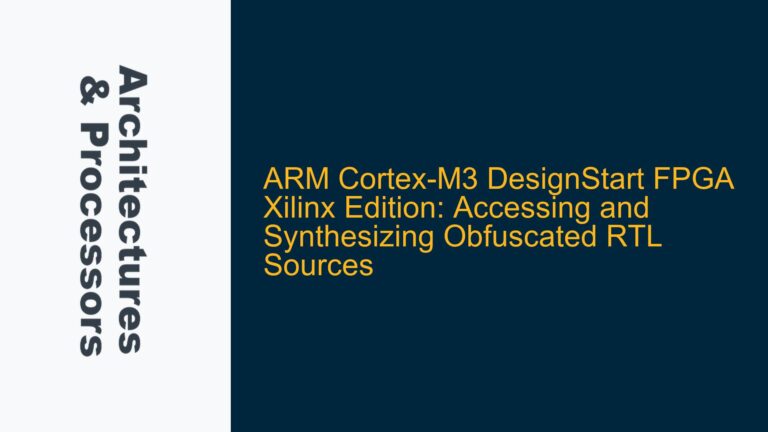ARM CI-700 HN-F Invisible Cache Architecture and Context Switching Challenges
The ARM CI-700 HN-F interconnect implements an invisible cache, a unique architectural feature that significantly impacts system performance and software behavior, particularly during context switches between cacheable and non-cacheable memory regions. Unlike traditional caches, the invisible cache operates beyond the point of coherency, meaning its behavior is transparent to software and not directly managed through standard Cache Maintenance Operations (CMOs). This design choice eliminates the need for explicit cache maintenance during context switches, but it also introduces complexities that developers must understand to ensure system correctness and performance.
The invisible cache is typically the last cache level before main memory, acting as a bridge between the processor and DRAM. It caches all memory requests, regardless of their memory attributes (e.g., cacheable vs. non-cacheable). This behavior contrasts with traditional caches, which respect memory attributes and require explicit CMOs to maintain data consistency when switching between memory types. For example, in a traditional cache, a context switch from cacheable to non-cacheable memory would necessitate cleaning or invalidating the cache to prevent stale data from being accessed. However, the CI-700 HN-F’s invisible cache bypasses this requirement because it does not distinguish between cacheable and non-cacheable requests at the hardware level.
This architectural decision has profound implications for system design and software development. While it simplifies certain aspects of cache management, it also introduces potential pitfalls, particularly in systems where memory attributes and shareability domains are critical. Developers must be aware of how the invisible cache interacts with other system components, such as DMA controllers and multi-core processors, to avoid data consistency issues and performance bottlenecks.
Memory Attribute Ignorance and Cache Coherency Implications
The primary challenge with the CI-700 HN-F’s invisible cache stems from its disregard for memory attributes. In a traditional cache, memory attributes such as cacheability, shareability, and memory type (e.g., device, normal) dictate how data is stored and accessed. For instance, non-cacheable memory regions are typically bypassed by the cache, ensuring that all accesses go directly to main memory. This behavior is critical for maintaining data consistency in systems with mixed memory types, such as those involving DMA transfers or memory-mapped I/O.
However, the invisible cache does not enforce these distinctions. It treats all memory requests uniformly, caching data regardless of its attributes. This behavior can lead to subtle issues, particularly in systems where memory attributes are used to enforce specific access patterns or data consistency guarantees. For example, consider a scenario where a DMA controller writes data to a non-cacheable memory region. In a traditional system, the processor would access this data directly from main memory, bypassing the cache. However, with the invisible cache, the processor might inadvertently access stale data from the cache, leading to data corruption or incorrect program behavior.
Another critical implication of the invisible cache’s behavior is its impact on cache coherency. In a multi-core system, cache coherency protocols ensure that all cores see a consistent view of memory. However, the invisible cache operates beyond the point of coherency, meaning it is not directly managed by these protocols. This can lead to situations where one core modifies data in the invisible cache, but the change is not immediately visible to other cores. Such scenarios can result in subtle bugs that are difficult to diagnose and reproduce.
To mitigate these issues, developers must adopt a proactive approach to cache management. This includes understanding the specific behavior of the invisible cache and implementing appropriate software mechanisms to ensure data consistency. For example, explicit memory barriers or cache maintenance operations may be required in certain scenarios to enforce the desired memory semantics.
Implementing Data Synchronization and Cache Management Strategies
To address the challenges posed by the CI-700 HN-F’s invisible cache, developers must adopt a combination of hardware-aware software design and rigorous testing. The following strategies can help ensure correct system behavior and optimal performance:
-
Explicit Memory Barriers: Since the invisible cache does not respect memory attributes, developers must use explicit memory barriers to enforce the desired memory ordering and visibility. Memory barriers ensure that all memory operations before the barrier are completed before any operations after the barrier are executed. This is particularly important in multi-core systems, where the invisible cache’s behavior can lead to inconsistent views of memory.
-
Cache Maintenance Operations (CMOs): While the invisible cache itself does not respond to standard CMOs, developers must still use these operations to manage other caches in the system. For example, if a context switch involves transitioning from cacheable to non-cacheable memory, the L1 and L2 caches may need to be cleaned or invalidated to ensure data consistency. This step is critical to prevent stale data from being accessed during the context switch.
-
Hardware-Specific Cache Management: In some cases, the invisible cache may provide implementation-specific mechanisms for cache management. Developers should consult the CI-700 HN-F documentation to identify any such features and incorporate them into their software design. For example, the hardware may provide a mechanism to flush or invalidate the invisible cache under specific conditions.
-
Rigorous Testing and Validation: Given the subtle nature of the issues that can arise with the invisible cache, developers must adopt a rigorous testing and validation process. This includes stress testing the system under various memory access patterns and verifying data consistency across all cores and memory regions. Tools such as cache simulators and memory analyzers can be invaluable in identifying and diagnosing potential issues.
-
Documentation and Code Comments: To ensure that the behavior of the invisible cache is well understood by all team members, developers should thoroughly document their cache management strategies and include detailed comments in the code. This practice helps prevent misunderstandings and ensures that future modifications to the software do not inadvertently introduce new issues.
By adopting these strategies, developers can effectively manage the challenges posed by the CI-700 HN-F’s invisible cache and ensure that their systems operate correctly and efficiently. While the invisible cache introduces unique complexities, a thorough understanding of its behavior and careful software design can mitigate these challenges and unlock the full potential of the ARM architecture.
Conclusion
The ARM CI-700 HN-F’s invisible cache represents a powerful but complex architectural feature that requires careful consideration during system design and software development. By understanding its behavior and implementing appropriate cache management strategies, developers can ensure data consistency, optimize performance, and avoid subtle bugs. The key to success lies in a combination of hardware-aware software design, rigorous testing, and thorough documentation. With these practices in place, the invisible cache can be a valuable asset in building high-performance, reliable embedded systems.






